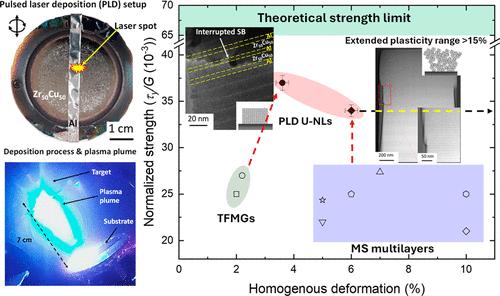当前位置:
X-MOL 学术
›
ACS Appl. Mater. Interfaces
›
论文详情
Our official English website, www.x-mol.net, welcomes your feedback! (Note: you will need to create a separate account there.)
Novel Class of Crystal/Glass Ultrafine Nanolaminates with Large and Tunable Mechanical Properties
ACS Applied Materials & Interfaces ( IF 8.3 ) Pub Date : 2024-06-27 , DOI: 10.1021/acsami.4c02610 Francesco Bignoli 1, 2 , Philippe Djemia 1 , Giancarlo Terraneo 3 , Gregory Abadias 4 , Christoph Gammer 5 , Alice Lassnig 5 , Camila A. Teixeira 6 , Subin Lee 6 , Ali Ahmadian 7 , Andrea Li Bassi 2 , Damien Faurie 1 , Matteo Ghidelli 1
ACS Applied Materials & Interfaces ( IF 8.3 ) Pub Date : 2024-06-27 , DOI: 10.1021/acsami.4c02610 Francesco Bignoli 1, 2 , Philippe Djemia 1 , Giancarlo Terraneo 3 , Gregory Abadias 4 , Christoph Gammer 5 , Alice Lassnig 5 , Camila A. Teixeira 6 , Subin Lee 6 , Ali Ahmadian 7 , Andrea Li Bassi 2 , Damien Faurie 1 , Matteo Ghidelli 1
Affiliation

|
The control of local heterogeneities in metallic glasses (MGs) represents an emerging field to improve their plasticity, preventing the propagation of catastrophic shear bands (SBs) responsible for the macroscopically brittle failure. To date, a nanoengineered approach aimed at finely tuning local heterogeneities controlling SB nucleation and propagation is still missing, hindering the potential to develop MGs with large and tunable strength/ductility balance and controlled deformation behavior. In this work, we exploited the potential of pulsed laser deposition (PLD) to synthesize a novel class of crystal/glass ultrafine nanolaminates (U-NLs) in which a ∼4 nm thick crystalline Al separates 6 and 9 nm thick Zr50Cu50 glass nanolayers, while reporting a high density of sharp interfaces and large chemical intermixing. In addition, we tune the morphology by synthesizing compact and nanogranular U-NLs, exploiting, respectively, atom-by-atom or cluster-assembled growth regimes. For compact U-NLs, we report high mass density (∼8.35 g/cm3) and enhanced and tunable mechanical behavior, reaching maximum values of hardness and yield strength of up to 9.3 and 3.6 GPa, respectively. In addition, we show up to 3.6% homogeneous elastoplastic deformation in compression as a result of SB blocking by the Al-rich sublayers. On the other hand, nanogranular U-NLs exhibit slightly lower yield strength (3.4 GPa) in combination with enhanced elastoplastic deformation (∼6%) followed by the formation of superficial SBs, which are not percolative even at deformations exceeding 15%, as a result of the larger free volume content within the cluster-assembled structure and the presence of crystal/glass nanointerfaces, enabling to accommodate SB events. Overall, we show how PLD enables the synthesis of crystal/glass U-NLs with ultimate control of local heterogeneities down to the atomic scale, providing new nanoengineered strategies capable of deep control of the deformation behavior, surpassing traditional trade-off between strength and ductility. Our approach can be extended to other combinations of metallic materials with clear interest for industrial applications such as structural coatings and microelectronics (MEMS and NEMS).
中文翻译:

具有大且可调机械性能的新型晶体/玻璃超细纳米层压材料
金属玻璃(MG)局部异质性的控制代表了一个新兴领域,旨在提高其可塑性,防止导致宏观脆性破坏的灾难性剪切带(SB)的传播。迄今为止,仍然缺乏旨在精细调节控制SB成核和传播的局部异质性的纳米工程方法,这阻碍了开发具有大且可调节的强度/延展性平衡和受控变形行为的MG的潜力。在这项工作中,我们利用脉冲激光沉积 (PLD) 的潜力来合成一类新型晶体/玻璃超细纳米层压材料 (U-NL),其中 ∼4 nm 厚的晶体 Al 分离 6 和 9 nm 厚的 Zr 50 Cu 50 玻璃纳米层,同时报告了高密度的尖锐界面和大量的化学混合。此外,我们通过合成致密和纳米颗粒的 U-NL,分别利用逐个原子或簇组装的生长方式来调整形态。对于紧凑的U-NL,我们报告了高质量密度(∼8.35 g/cm 3 )和增强且可调节的机械行为,硬度和屈服强度的最大值分别高达9.3和3.6 GPa。此外,由于富铝亚层的 SB 阻挡,我们在压缩过程中显示出高达 3.6% 的均匀弹塑性变形。另一方面,纳米颗粒 U-NL 表现出略低的屈服强度(3.4 GPa),并结合增强的弹塑性变形(∼6%),随后形成表面 SB,即使变形超过 15%,其也不会渗透,作为这是簇组装结构内较大的自由体积含量以及晶体/玻璃纳米界面的存在的结果,能够适应SB事件。 总的来说,我们展示了 PLD 如何能够合成晶体/玻璃 U-NL,最终控制原子尺度的局部异质性,提供能够深度控制变形行为的新纳米工程策略,超越强度和延展性之间的传统权衡。我们的方法可以扩展到对工业应用有明确兴趣的其他金属材料组合,例如结构涂层和微电子(MEMS 和 NEMS)。
更新日期:2024-06-27
中文翻译:

具有大且可调机械性能的新型晶体/玻璃超细纳米层压材料
金属玻璃(MG)局部异质性的控制代表了一个新兴领域,旨在提高其可塑性,防止导致宏观脆性破坏的灾难性剪切带(SB)的传播。迄今为止,仍然缺乏旨在精细调节控制SB成核和传播的局部异质性的纳米工程方法,这阻碍了开发具有大且可调节的强度/延展性平衡和受控变形行为的MG的潜力。在这项工作中,我们利用脉冲激光沉积 (PLD) 的潜力来合成一类新型晶体/玻璃超细纳米层压材料 (U-NL),其中 ∼4 nm 厚的晶体 Al 分离 6 和 9 nm 厚的 Zr 50 Cu 50 玻璃纳米层,同时报告了高密度的尖锐界面和大量的化学混合。此外,我们通过合成致密和纳米颗粒的 U-NL,分别利用逐个原子或簇组装的生长方式来调整形态。对于紧凑的U-NL,我们报告了高质量密度(∼8.35 g/cm 3 )和增强且可调节的机械行为,硬度和屈服强度的最大值分别高达9.3和3.6 GPa。此外,由于富铝亚层的 SB 阻挡,我们在压缩过程中显示出高达 3.6% 的均匀弹塑性变形。另一方面,纳米颗粒 U-NL 表现出略低的屈服强度(3.4 GPa),并结合增强的弹塑性变形(∼6%),随后形成表面 SB,即使变形超过 15%,其也不会渗透,作为这是簇组装结构内较大的自由体积含量以及晶体/玻璃纳米界面的存在的结果,能够适应SB事件。 总的来说,我们展示了 PLD 如何能够合成晶体/玻璃 U-NL,最终控制原子尺度的局部异质性,提供能够深度控制变形行为的新纳米工程策略,超越强度和延展性之间的传统权衡。我们的方法可以扩展到对工业应用有明确兴趣的其他金属材料组合,例如结构涂层和微电子(MEMS 和 NEMS)。











































 京公网安备 11010802027423号
京公网安备 11010802027423号